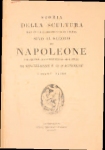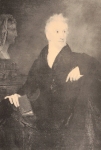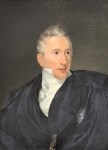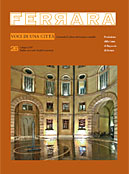Uscito dal convento piacentino, e sbattendo la porta, terminati gli studi universitari nello Studio di Parma, lungo il filo d'una tradizione tipica in loco, quella di Condillac, aggiornata moderatamente da Herder, il giovane -in contrasto violento col padre- tentò le vie della nuova burocrazia prefettizia e del governo cisalpino, e poi italico. Fu in questo modo che, accompagnato da una lettera molto impegnativa di Leopoldo Cicognara, da poco conosciuto a Ferrara, arrestò le sue prime esperienze amministrative e giuridiche a Bologna, anno 1804: e qui inaugurò un susseguirsi incessante di tentativi e di eventi tesi a trovare un lavoro culturale, il più mediocre dei quali -pro Segretario nella nuova Accademia di Belle Arti- gli apparve tuttavia come un'àncora di salvezza nell'estate del 1808. E in esso perseverò, nonostante tutto, fino alla Restaurazione. Conobbe una vita travagliata e povera, e nella trista stagione di quella società tempestosa temprò un suo carattere di combattuta, onesta opinione.
 Il suo temperamento non concessivo apparve assai spesso esemplato all'altezza della morale civile e dei fini sociali. Conobbe veri e falsi complessi di persecuzione, e in Bologna tentò con un senso di rivolta sempre intellettuale di affrontare certe tradizioni e alcuni modi spesso curiali o accademici, ereditati dalla letteratura e dalle arti della città. Dopo aver illuminato il ritratto ribelle del Risorgimento italiano, raccomandato da Carducci, ne scomparve, cancellato dal De Sanctis. Un ritratto recuperato all'altezza della sua sapiente onestissima morale e della vivida intelligenza moderna è quello recentemente restituitoci da Ezio Raimondi e da Andrea Battistini. Si annida nel complesso di "non finito" (assai più che di incompiuto) del Giordani, nel senso di un pensiero sempre condotto all'acme quasi spietata della sua analisi -e per questa stessa ragione mai terminato- nel modo che fu tipico di Pietro Giordani, la ragione profonda della condanna perfino angosciosa che condurrà lo scrittore a essere il costante propositore di temi e di problemi, di poesia e di analisi, e quell'eterno progettista di soggetti culturali che egli stesso peraltro non sarà mai in grado di fermare in un'opera di entità conclusa.
Il suo temperamento non concessivo apparve assai spesso esemplato all'altezza della morale civile e dei fini sociali. Conobbe veri e falsi complessi di persecuzione, e in Bologna tentò con un senso di rivolta sempre intellettuale di affrontare certe tradizioni e alcuni modi spesso curiali o accademici, ereditati dalla letteratura e dalle arti della città. Dopo aver illuminato il ritratto ribelle del Risorgimento italiano, raccomandato da Carducci, ne scomparve, cancellato dal De Sanctis. Un ritratto recuperato all'altezza della sua sapiente onestissima morale e della vivida intelligenza moderna è quello recentemente restituitoci da Ezio Raimondi e da Andrea Battistini. Si annida nel complesso di "non finito" (assai più che di incompiuto) del Giordani, nel senso di un pensiero sempre condotto all'acme quasi spietata della sua analisi -e per questa stessa ragione mai terminato- nel modo che fu tipico di Pietro Giordani, la ragione profonda della condanna perfino angosciosa che condurrà lo scrittore a essere il costante propositore di temi e di problemi, di poesia e di analisi, e quell'eterno progettista di soggetti culturali che egli stesso peraltro non sarà mai in grado di fermare in un'opera di entità conclusa.
A parte le molte, confessate ragioni psicologiche e il senso di fatica di cui lo scrittore soffriva, sembra davvero che al Giordani stesse più d'ogni altra cosa a cuore soprattutto il senso di un lavoro inteso come "officina" quando non soltanto come "progetto". Se non addirittura il concetto operante d'una "redazione" intellettuale di eguali, accordata tra le parti e indirizzata ai fini di una moderna volontà culturale. Emerge invece nell'opera dell'amico più vicino, e cioè proprio Leopoldo Cicognara, ormai destinato in parallelo alla direzione dell'Accademia di Venezia, quella specie di fervore critico e di volontà di espressione storica che dovette animare il suo proposito di affiancare la Storia Pittorica di Luigi Lanzi (uscita in edizione definitiva nel 1809) con una sua, necessaria, Storia della Scultura. Tra i due doveva correre negli anni un'amicizia degna dei più famosi personaggi dell'amistà contenuti nei poemi dell'antichità messa in voga dalle traduzioni famose di Monti e del Pindemonte.
Il Giordani, entrato a metà del 1808, nelle Belle Arti di Bologna, aveva la necessità di paragonare la sua personale capacità espressiva, a cominciare dalla stessa "lingua degli artisti", con una tradizione settecentesca di grande peso anche letterario: fino a sfiorare le cose, dirà, con la lingua degli "arcavoli" e cioè adottando le tardive capacità espressive dei vecchi bacucchi della tradizione letteraria. La lingua della storia, pensava il Giordani, maestro della retorica, deve vivere intatta, non può essere ancillare oppure imitativa alle immagini create ogni giorno dagli artisti. Tutta l'opera del critico risiedeva nell'attenzione posta all'impianto storico e ideologico della creazione, della sua necessità civile e infine nella sensibilità del rilievo etico che ne doveva emergere.
Lo scrittore aveva già tentato, nel 1806, di spingere la sua capacità di espressione morale, misurando diretta- mente il futuro della vita artistica bolognese e sospingendolo a una più accentuata ed esclusiva vita politica. Evocava, per questo, quella silente Sparta che era stata anche il modello del grande pittore J. L. David vent'anni prima, nel 1784. Bologna e gli amici (e i nemici) Accademici non furono, in realtà, mai pronti ad abbandonare la forte corazza d'una tradizione entro la quale, già dalla riforma dei Carracci, Felsina Pittrice si era protetta: in essa stavano i caratteri peculiari di quell'eclettismo naturalistico e insieme colto di cui il "grande stile" appariva ancora ammantato. La città, raccolta entro le sue rossa mura, non aveva in realtà misurato il suo presente in nessuna dimensione riformistica, e tanto meno rivoluzionaria.
Il neoclassicismo non l'aveva neppure sfiorata con qualcuna delle sue tensioni. Come avrebbe potuto aderire a un messaggio di quale valore, quando la sua storia seguitava a scorrere immutabile, protetta al modo che abbiamo detto da una sorta di intoccabile tradizione secolare? La riduzione moralistica del Giordani, una raffica di exempla gettata contro le grand Gout incontrò un vero disastro d'opinione, e impose le ragioni di un suo rapido allontanamento dalla città in una precipitosa fuga verso l'Umbria e Napoli, e infine a Roma, dove fortunatamente doveva tornare a incontrare proprio Leopoldo Cicognara, vedovo da poco della moglie Massimiliana Cislago, e impegnato -da pittore dilettante qual era- in un ritratto di Antonio Canova. Era il segno di un affetto divenuto quasi familiare.
E fu proprio in questo modo, con una naturalezza risanatrice di molte delle sue comprensibili nevrosi, che Pietro Giordani fu introdotto alla visita dello studio e alla presenza del grande scultore. Dalle parole dell'artista e dalla sua espressione di vita, di cultura, e anche di politica, nacque la forte ripresa dell'animo di Giordani e il seguito della sua avventura, che passerà entro breve nel pesante sforzo di costruzione -in Cesena- del discorso intitolato Panegirico a Napoleone Legislatore e, infine, all'incarico, stentato, ma irrinunciabile, di pro Segretario alla ormai avviata Accademia statale, e anzi Regia Imperiale, di vicolo della Paglia a Bologna Gli anni bolognesi, che si concluderanno nell'estate del 1815, e con il suo successivo esilio lombardo, sono quelli meno conosciuti e per irreperibilità delle sue imprese letterarie e orarie d'ufficio, e anche per la mancata conoscenza dello sviluppo dei modi e delle possibilità di esistenza di uno scrittore ospitato in una città difficile, se non ostile, con pochi amici e una frequentazione riservata a un milieu, quello napoleonico, di non semplice convivenza.
 Stupisce, forse, che proprio Sebastiano Timpanaro, il più fervido conoscitore moderno dell'attività letteraria del Giordani, abbia scostato dal suo tavolo le opere di questa età, che invece erano entrate nel precoce intendimento di Emma Montanari fin dal 1903¸ e che saranno riabilitate dal lavoro di Paola Barocchi (1972 e 1990). Pura e semplice ricerca ecfrastica, disse appunto lo studioso, forse trascurando il fatto che la critica d'arte appartiene spesso e quasi di necessità al mondo delle immagini narrate e trasposte in equivalenze. Ma ora, non si studia l'animo e neppure l'intenzione -così importante- del Giordani se non si fa ricorso, dal 1808 in avanti, alla conoscenza di Leopoldo Cicognara. E questa amicizia divenne d'una reciprocità irrinunciabile.
Stupisce, forse, che proprio Sebastiano Timpanaro, il più fervido conoscitore moderno dell'attività letteraria del Giordani, abbia scostato dal suo tavolo le opere di questa età, che invece erano entrate nel precoce intendimento di Emma Montanari fin dal 1903¸ e che saranno riabilitate dal lavoro di Paola Barocchi (1972 e 1990). Pura e semplice ricerca ecfrastica, disse appunto lo studioso, forse trascurando il fatto che la critica d'arte appartiene spesso e quasi di necessità al mondo delle immagini narrate e trasposte in equivalenze. Ma ora, non si studia l'animo e neppure l'intenzione -così importante- del Giordani se non si fa ricorso, dal 1808 in avanti, alla conoscenza di Leopoldo Cicognara. E questa amicizia divenne d'una reciprocità irrinunciabile.
Hanno inizio in modo irruento e con un sollecito entusiasmo di metodo, proiettato altresì nel futuro dell'opera immaginata, e cioè la Storia della Scultura, le note, le lettere e gli appunti con le fitte dichiarazioni di cui si intesse l'amicizia partecipe dei due scrittori. Il fatto che le lettere indirizzate al Giordani siano state -come di norma decideva il piacentino- distrutte e bruciate da lui per il timore della censura, bestia nera di quegli anni, resta il fatto che la Biblioteca Ariostea di Ferrara abbia conservato in eredità la consistente, pressoché quotidiana e generosamente suggeritiva sequenza epistolare inviata dal Giordani al Cicognara (per lo più a Venezia) che guidò e soccorse nel modo da lui stesso dichiarato all'uscita del VIII volume della Storia.
La scultura occupava un ruolo molto importante entro il vecchio "primato delle arti" dibattuto in età neoclassica e anzi purista. Lo voleva la tradizione interpretativa di Winckelmann, l'opinione stessa di Hegel: dal cuore -della volontà politica della stagionela scultura era la cosa più "italiana" e memore del Rinascimento che si potesse ricordare. E questa italia-nità, questa misura molto nazionale, che tornava anche a vivere nel successo universale di Antonio Canova, era un argomento determinante per i due scrittori, così per il Cicognara che per l'amico suo Giordani. La loro fu, infatti, anche una significativa collaborazione politica.
La vicenda intellettuale e la sua vita stessa di progetto e di redazione, di officina scrittoria, si trova sedimentata e insieme esposta, minuziosamente argomentata proprio nella lettere spedite a Venezia all'amico Cicognara. Al punto di far disperare della bontà d'ogni ricognizione sul lavoro dello scrittore piacentino fino al momento nel quale la raccolta epistolare ferrarese non sarà debitamente ordinata e specificamente analizzata e interpretata. Gran parte della stagione bolognese del Giordani si trova non dico aggregata, ma addirittura contenuta in quelle straordinarie carte, documenti d'una letterale trasposizione dall'uno all'altro corpo, nel metro di comportamenti di valore -come già si è detto- del tutto moderni.
Nel giro di qualche mese, dopo l'inizio dei corsi nel 1808, negli atelier di pittura, di scultura o di scenografia, fino a quello popolarissimo di ornato, l'insegnamento maggiormente raccomandato come la disciplina di ogni decorazione e anche nel design di interni domestici e borghesi, l'Accademia prende vita: e sostituisce la vecchie Clementina anch'essa degna di memoria per aver avuto come insegnanti i maggiori artisti del Settecento, dai Colonna ai Gandolfi ai Bibiena stessi.
Oggi la nuova scuola deve dispensare insegnamenti più vasti e consentire anche un'informazione ideologica e letteraria: dal Winckelmann al Milizia. Molti artisti più giovani si riunivano presso l'abitazione del Giani, chiamandola la Casa delle Idee, dove si discuteva il futuro dell'arte a Faenza divenuta in pochi anni la centrale d'una architettura globale e assai rara in questa completezza. La stagione vivacemente neoclassica della Atene della Romagna era stata progettata e allestita da uomini come Achille Laderchi, e da architetti quali Giuseppe Pistocchi e Giovanni Antonio Antolini, da plasticatori come quelli della squisita bottega dei Ballanti Graziani e, infine, dell'efficacissimo narratore d'ogni "antico" mitologico e simbolistico, il pittore Felice Giani.
Tutta la città è attraversata, tra classicismo e purismo, da una folata creativa imparagonabile per la sua fulminea qualità e bellezza a ogni altro centro italiano. Una ricchezza di premodernissima espansione come quella faentina, avvantaggiata anche dal vettore formale e ideologico della produzione ceramica, meriterebbe un'analisi internazionale e generale di studio, come da decenni propone e disegna l'architetto Franco Bertoni. La divisa del Giordani è quella della retorica, paragonata -come egli stesso diceva- a una lingua elementare creata sui Fioretti di San Francesco oppure di fra' Domenico Cavalca, ma intessuta nella sintassi della Grecia Attica. A queste dichiarazioni, e ad altre, l'adolescente Leopardi si accese d'una fervida amicizia per Pietro G iordani, che andò a conoscere il giovane di persona a Recanati, mettendo in allarme - ecomprensibilmente- il padre Monaldo. Affrontato con un'occhiata più eccitata dalle novità di quegli anni, egli è un formidabile scrittore di lettere, oltre tutto cultore di un acceso gossip culturale e d'una discussione intellettuale geniale, senza paragoni.
 Un campione dell'informazione culturale, venato da una spietata sincerità e oppresso dal proprio isolamento di decenni di vita difficile: nel cuore d'una trasformazione sociale ed economica dove si perdono tutti i canoni della vita tradizionale, dalla devozione religiosa alla sua protezione nobiliare o parrocchiale.
Un campione dell'informazione culturale, venato da una spietata sincerità e oppresso dal proprio isolamento di decenni di vita difficile: nel cuore d'una trasformazione sociale ed economica dove si perdono tutti i canoni della vita tradizionale, dalla devozione religiosa alla sua protezione nobiliare o parrocchiale.
Pietro Giordani è uno scrittore di interni che pone cura solo nelle amicizie perfette: e tra queste si annoverano soprattutto le virtù di alcune belle donne, come tra tutte Cornelia Rossi Martinetti, la Venere
bruna, una tra la Grazie del Foscolo, e scienziati di mitica virtù come il sapiente cardinal Mezzofanti, un poliglotta stupefacente; ovvero dell'antichista Filippo Schiassi. Leopoldo Cicognara entra in questo novero e soprattutto nell'area ferrarese e veneziana. Le visite di Antonio Canova, accompagnato dall'abate Sartori - suo fratellastro- saranno anche nella Bologna della giovinezza e nell'Accademia di via Belle Arti eventi di esaltante misura morale e di straordinaria attesa artistica. Intorno al 1810, il nostro Giordani, nelle aule fredde dell'ex Collegio dei Gesuiti, aveva iniziato a scrivere un Panegirico di Antonio Canova che non troverà mai conclusione. A dire il vero, esso diverrà un vero e proprio nevrotico cauchemar, un tormentone inesauribile dove scaricare imponenti complessi di colpa e quel senso del non finito di cui si è già detto prima.
Tra il suo ingresso nell'Accademia nel 1808 e il relativo stabilizzarsi di quell'incarico pieno di personali difficoltà, egli tentò di avvicinare in più modi la sua maestria retorica alle sperimentali consuetudini della vita artistica dell'istituzione. Intervenne scrivendo la vita dell'ornatista Vincenzo Martinelli nei suoi stessi modi, e in linguaggio critico che era paragonabile a quello di Luigi Lanzi. Affrontò qualche moderna esperienza, recandosi a Piacenza per studiare le recenti opere di Gaspare Landi e di Vincenzo Camuccini. Si dedicò a un progetto di filologia critico-storica modellato sull'opera di Innocenzo da Imola e, infine, diede inizio a un'esperienza critica indirizzata alla scultura e ai "Sepolcri" (1813). Questa fu l'ultima sua suggestione prima di Waterloo e dell'ostracismo da Bologna.
Questa sperimentazione, ogni volta ammirevole, e sempre interrotta, tornò a vestirsi d'una magistrale volontà e di valore retorico. Ma il vero confronto con l'arte il Giordani lo toccò nell'incontro con la bellezza e l'umana misura di Antonio Canova. La sua vita fu assai lunga, e tuttavia attraversata in ogni circostanza da instabili eventi, da esperienze sempre impervie. La sua moralità aggredita dalla volontà d'una sperimentazione molto moderna, non fu mai in grado di dare un reale completamento a qualche sua opera di reale prestigio critico e storico. E sì che la sua intelligenza ne progettò molti e densi di significato letterario e civile.
Entrando nel vivo dell'impostazione della Storia progettata dal Cicognara, inedita per l'Italia, Pietro Giordani avrà modo di esporre la sua avversione per un secolo come il Settecento e di caricare invece la qualità della grandezza storica del secolo barocco e della scienza. Così suggeriva infatti al Cicognara: "direi dunque in pochissime parole che l'Italia nel ‘700 fu minore di quello che era stata nel secolo precedente: nel quale davvero fu grandissima per la copia delle invenzioni e degli inventori; e fu maestra delle alternazioni". Un altro giudizio esemplare da ricordare è quello relativo ai cardini del neoclassicismo: "analizzerei l'influenza, qualunque fosse, che esercitò Mengs sopra le arti; e l'effetto che risultò dai precetti di Algarotti, dalle declamazioni di Milizia, dalla fantasia di Winckelmann. Ciò appena fu tocco; e vorrebbe sviluppo. Ma questi scritti potevano indebolire o anche distruggere qualche error di massima: se non veniva in aiuto l'esempio del divino Canova, nulla si sarebbe fatto".
In realtà il testo del Cicognara a riguardo di Canova, ovvia conclusione dell'opera storica, incontrò qualche difficoltà. Ma in generale l'impresa della Storia ebbe necessità di un forte sostegno. Pietro Giordani intervenne già nel dicembre del 1809 con una familiarissima sintassi, e disse: "Ma per tutti gli dei che fermissimamente io credo voi attissimo a ciò, ne' io conosco altri ai quali volessi con eguale fiducia di successi imporre tal opera". Di fronte alle discussioni serrate circa la strutturazione dei volumi, egli era allettato dal quadro sinottico che stava nelle intenzioni del Cicognara; e lo diceva apertamente: "A me particolarmente diletta, come cosa sommamente filosofica, quel paragone che per ogni epoca farete della stato della scultura collo stato della politica e delle scienze".
Già anni avanti, lo scultore aveva avuto modo di intervenire per ridurre il forte peso assegnato alla personalità plastica di Michelangelo. Ma ora, il Canova non riuscì soddisfatto a proposito del III tomo, tanto che nell'agosto del 1817 provvide a spedire al Cicognara la bellezza di diciassette pagine fitte di postille e di annotazioni. Anch'egli era stato assalito da quella specie di agiografia che il Canova stesso aveva lentamente collaborato a erigere nei decenni Fu l'abate Sartori, fratrellastro dello scultore, che si incaricò di mediare fra i due. Pietro Giordani prese un poco le distanze e venne precisando che il libro era anzitutto di studio: "E in quella sua maniera più fredda e posata parmi che sia proceduto: e che ne risulti gran lode al divino, tanto più efficace quanto più indiretta e rimota da ambizione oratoria" (IV, pp. 105- 106). Per quanto poi riguarda l'effettiva qualità del saggio, è parere di Gianni Venturi che esso riuscisse alla fine "il meno sicuro e il più ambiguo di tutta la storia". Il processo di autocostruzione della personalità era di fatto adduggiato dalla ostentata costruzione d'una pretesa modestia. La costruzione del Canova come maestro dell'ideale non fu argomento di agevole difesa critica: in realtà poco del Canova si avvia alla normativa sollecitata dal neoclassicismo. Egli domina la forma classica e mostra insieme una notevole libertà interpretativa. In questo senso, fu necessario al Cicognara di tornare a polemizzare a distanza con le teorie che il tedesco Fernow aveva già divulgato anni addietro, nel 1806, e che accreditavano allo scultore solo la più amabile grazia (Lieblickeit) destinata ad agire sui sensi, ma assai meno sull'intelligenza. Un'altra significativa discrasia delimitava il rapporto tra lo scultore e il Cicognara, ed era quella che si potrebbe definire della normativa dell'"antico" inteso come insegnamento assoluto. Infatti, il Canova, specie dopo la sua velocissima visita a Londra nell'autunno tardo del 1815, onde vedere direttamente i marmi di Lord Elgin allineati finalmente nel British Museum, non nasconderà per nulla una sua reazione di tipo marcatamente naturalistico, fornendo in tal modo ai suoi amici più ortodossi, spettatori di un neoclassicismo più assoluto e severo, altri materiali per una delusione rinnovata. Si deve nell'occasione rimandare all'esemplare libro di Francesca Fedi, edito nel 1990 con il titolo L'ideologia del Bello.
Nell'ultimo capitolo del volume VIII della sua Storia, il Cicognara rendeva dichiarazione piena al suo debito; e più che parlare d'una collaborazione affettiva scriveva d'una partecipazione in questi termini: "Questi fu Pietro Giordani... il quale muoveva continua querela per la scrittura propriamente detta, o più propriamente quella che dai Pisani a Canova racchiude il giro di sei secoli, fosse rimasta finora senza uno storico". L'inizio della sua Storia della Scultura, suggeriva Giordani, decorreva dalla Geshichte der Kunst des Altertums di J. J. Winckelmann: storia, dunque, degli scultori, e non della scultura. "Egli nutriva ferma la convinzione che l'amico Cicognara dovesse indirizzarsi a problemi di indole filosofica e storica, e per questa ragione si confermò nell'opinione di doverlo aiutare proprio nell'organizzazione d'una più pratica filologia"..




